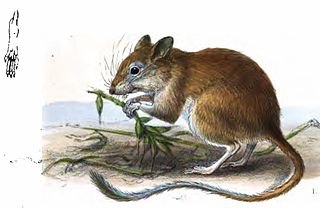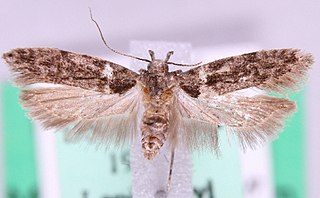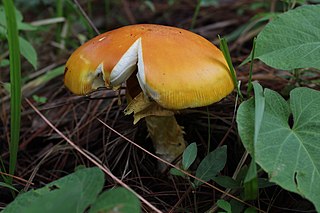
The Eurasian teal, common teal, or Eurasian green-winged teal is a common and widespread duck that breeds in temperate Eurosiberia and migrates south in winter. The Eurasian teal is often called simply the teal due to being the only one of these small dabbling ducks in much of its range. The bird gives its name to the blue-green colour teal.

The Balochistan gerbil or dwarf gerbil, is distributed mainly from Morocco across north Africa, the Arabian Peninsula, the Middle East, and western Asia. This is a common species with a wide distribution which faces no obvious threats, so the International Union for Conservation of Nature has rated its conservation status as being of "least concern".

Allen's spotted bat is a species of vesper bat in the family Vespertilionidae found in the Central African Republic, the Democratic Republic of the Congo, Kenya, and Uganda. It is found in subtropical or tropical moist lowland forests.

The short-palated fruit bat is a species of frugivorous megabat in the family Pteropodidae. It is found in Cameroon, Central African Republic, and Democratic Republic of the Congo. Its natural habitat is subtropical or tropical moist lowland forests. Births occur in May.
Carpatolechia is a genus of moths in the family Gelechiidae.

Carpatolechia proximella is a moth of the family Gelechiidae. It is found in most of Europe, Turkey, the Caucasus, Central Asia and Siberia.

Carpatolechia decorella is a moth of the family Gelechiidae. It is found in most of Europe, as well as in Turkey, the Caucasus, Kazakhstan, North Africa and on the Canary Islands.
Carpatolechia aenigma is a moth of the family Gelechiidae. It is found in France, Germany, the Netherlands, Italy, Austria, the Czech Republic, Slovakia, Poland, Hungary, Romania, Greece, Ukraine and Russia.

Carpatolechia alburnella, the suffused groundling, is a moth of the family Gelechiidae. It is found from most of Europe to Siberia. The habitat consists of woodland and heathland.
Carpatolechia filipjevi is a moth of the family Gelechiidae. It is found in Russia.

Carpatolechia fugacella is a moth of the family Gelechiidae. It is found in large parts of Europe, except Ireland, Great Britain, Scandinavia, Portugal, the western and southern part of the Balkan Peninsula, Ukraine, Lithuania and Estonia.

Carpatolechia fugitivella, the elm groundling, is a moth of the family Gelechiidae. It is found in almost all of Europe, Turkey, the Caucasus, Mongolia, southern Siberia, the Russian Far East and Korea. It is also found in Canada, where it has been recorded from Ontario and Quebec. The habitat consists of woodland, parks, gardens and hedgerows.

Carpatolechia notatella, the sallow-leaf groundling, is a moth of the family Gelechiidae. It is found in most of Europe and Turkey.
Carpatolechia longivalvella is a moth of the family Gelechiidae. It is found in South Korea.
Carpatolechia deogyusanae is a moth of the family Gelechiidae. It is found in South Korea.
Carpatolechia digitilobella is a moth of the family Gelechiidae. It is found in Korea and Japan.
Carpatolechia daehania is a moth of the family Gelechiidae. It is found in South Korea and Japan.
Teleiodes flavipunctatella is a moth of the family Gelechiidae. It is found in Korea.

Amanita basii is a mushroom of the family Amanitaceae.
Amanita viscidolutea is a species of agaric fungus in the family Amanitaceae native to Brazil, first described by Menolli, Capelari & Baseia in 2009. It is listed as a vulnerable species on IUCN Red List.









